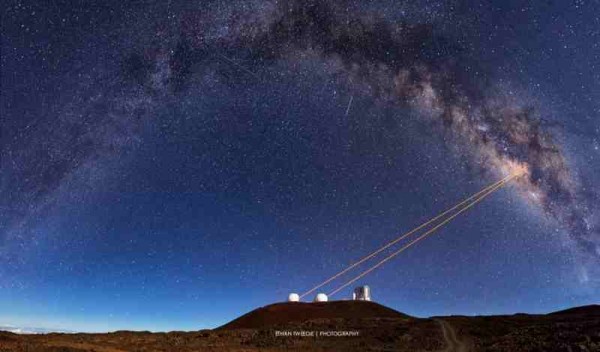Scientists Identify Mysterious Object at the Milky Way's Center
| Ana Verayo | | Nov 04, 2014 09:16 AM EST |
(Photo : Ethan Tweedie) Telescopes from Hawaii’s W.M. Keck Observatory discovered that G2 is a pair of binary stars that merged together, cloaked in gas and dust.
A new study reveals the mystery behind the massive bizarre object located in the center of the Milky Way galaxy that has puzzled astronomers for years.
The object is apparently a pair of binary stars that have merged.
This object known as G2 was long believed to be a hydrogen gas cloud gravitating towards the Milky Way's gigantic black hole.
Like Us on Facebook
Astronomers from the University of California closely studied the phenomenon last summer and said they've solved the mystery. According to lead researcher Andrea Ghez, who's also a professor of physics and astronomy at UCLA, this object is actually a pair of binary stars.
This pair has transformed into an extremely huge star shrouded in gas and dust because its movements are being manipulated by the black hole's intensely powerful gravitational field.
Astronomers reckon that if G2 was an actual hydrogen cloud, the black hole would have destroyed it a long time ago. This event would have resulted in a massive intergalactic explosion that would have significantly changed the black hole's state.
Ghez elaborates that G2 has been sitting pretty in its orbit, a phenomenon possible only with a gas cloud. G2 was actually left unaffected by the black hole.
Ghez has been studying thousands of star systems in the vicinity and outskirts of the colossal black hole. G2 is a new emerging class of stars formed near black holes due to powerful gravitational forces that merge binary stars into one.
During the merging of two stars, one star suffers an abrasion to its outermost layer but will continue to exist now as a supermassive star. It's also common in the Milky Way system for massive stars to pair up.
Ghez also describes this event as a "spaghetti-fication" where objects near black holes become elongated. This research was conducted at Hawaii's WM Keck Observatory that is home to the world's two biggest optical and infrared telescopes.
TagsMysterious Object Found in Center of Milky Way Beside Black Hole Solved, G2 object milky way galaxy black hole, G2 binary star, Black Holes, milky way galaxy
©2015 Chinatopix All rights reserved. Do not reproduce without permission
EDITOR'S PICKS
-

Did the Trump administration just announce plans for a trade war with ‘hostile’ China and Russia?
-

US Senate passes Taiwan travel bill slammed by China
-

As Yan Sihong’s family grieves, here are other Chinese students who went missing abroad. Some have never been found
-

Beijing blasts Western critics who ‘smear China’ with the term sharp power
-

China Envoy Seeks to Defuse Tensions With U.S. as a Trade War Brews
-

Singapore's Deputy PM Provides Bitcoin Vote of Confidence Amid China's Blanket Bans
-

China warns investors over risks in overseas virtual currency trading
-

Chinese government most trustworthy: survey
-

Kashima Antlers On Course For Back-To-Back Titles
MOST POPULAR
LATEST NEWS
Zhou Yongkang: China's Former Security Chief Sentenced to Life in Prison

China's former Chief of the Ministry of Public Security, Zhou Yongkang, has been given a life sentence after he was found guilty of abusing his office, bribery and deliberately ... Full Article
TRENDING STORY

China Pork Prices Expected to Stabilize As The Supplies Recover

Elephone P9000 Smartphone is now on Sale on Amazon India

There's a Big Chance Cliffhangers Won't Still Be Resolved When Grey's Anatomy Season 13 Returns

Supreme Court Ruled on Samsung vs Apple Dispute for Patent Infringement

Microsoft Surface Pro 5 Rumors and Release Date: What is the Latest?










